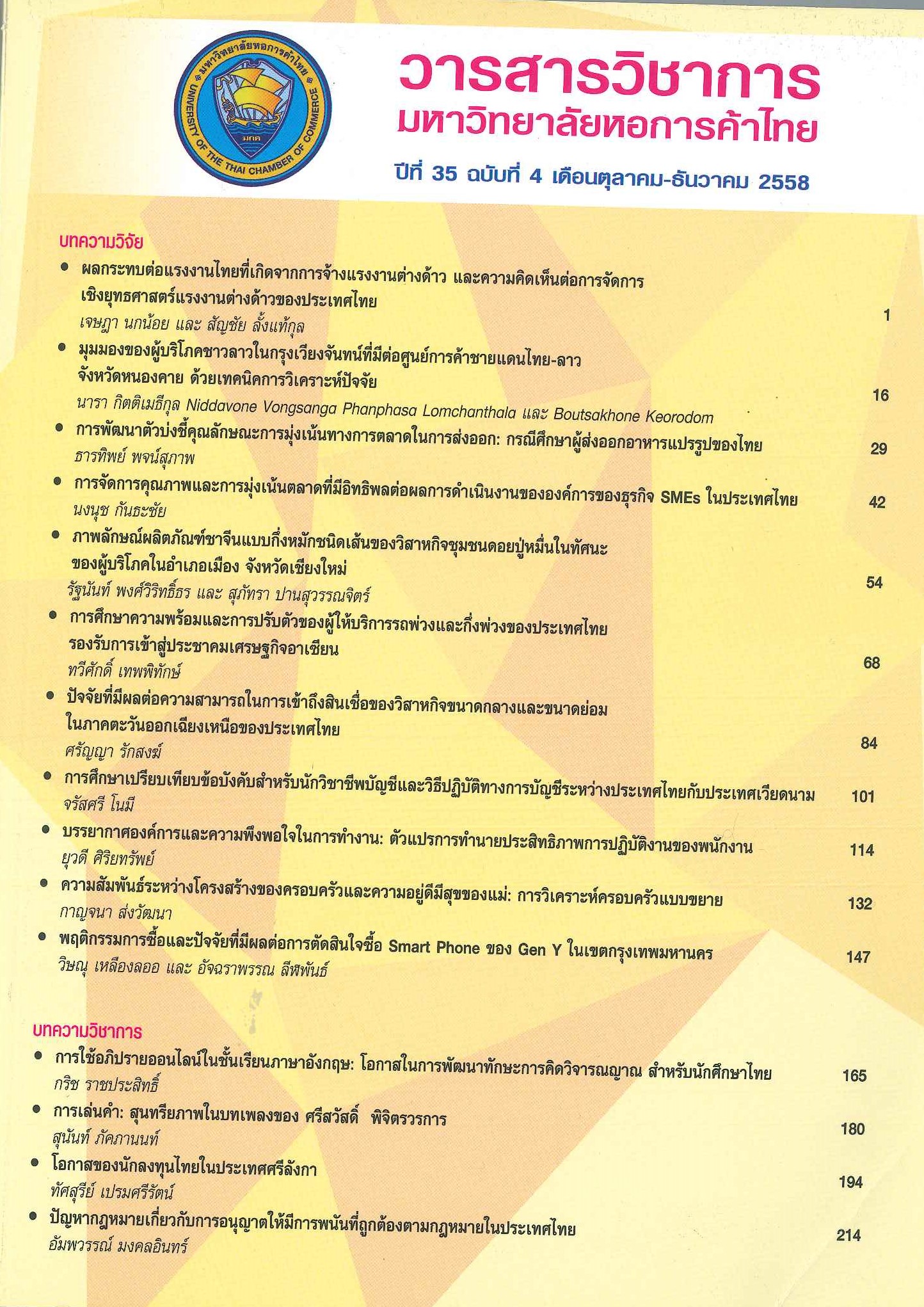ความสัมพันธ์ระหว่างโครงสร้างของครอบครัวและความอยู่ดีมีสุขของแม่: การวิเคราะห์ครอบครัวแบบขยาย
Main Article Content
บทคัดย่อ
จากอัตราการหย่าร้างที่สูงขึ้นส่งผลให้จำนวนแม่ที่เลี้ยงลูกคนเดียวเพิ่มสูงขึ้นตามลำดับ งานวิจัยนี้มีจุดประสงค์ที่จะศึกษาความสัมพันธ์ระหว่างโครงสร้างของครอบครัวและความอยู่ดีมีสุขของแม่ โดยมุ่งเน้นไปที่บทบาทของครอบครัวแบบขยายต่อความอยู่ดีมีสุขของแม่ งานวิจัยนี้ใช้ข้อมูลจากการสัมภาษณ์เชิงลึกกลุ่มตัวอย่าง จำนวน 210 คน ในจังหวัดกรุงเทพมหานคร จากการใช้สมการถดถอยวิธีกำลังสองน้อยที่สุดและโลจิสติกส์ พบว่า แม่ที่อาศัยอยู่ในครอบครัวแบบขยายจะมีความอยู่ดีมีสุขที่สูงขึ้นจากความเครียดของแม่ในการเลี้ยงดูลูกที่ลดลง ดังนั้นนโยบายการส่งเสริมการสร้างครอบครัวแบบขยายควรจะได้รับการสนับสนุน เพื่อเป็นการแบ่งเบาภาระของแม่ และสร้างเสริมสัมพันธ์ของคนในครอบครัว อันจะเป็นจุดเริ่มต้นของสังคมที่ยั่งยืน
Article Details
ลิขสิทธิ์ของบทความ
ผลงานที่ได้รับการตีพิมพ์ถือเป็นลิขสิทธิ์ของมหาวิทยาลัยหอการค้าไทย ห้ามมิให้นำเนื้อหา ทัศนะ หรือข้อคิดเห็นใด ๆ ของผลงานไปทำซ้ำ ดัดแปลง หรือเผยแพร่ ไม่ว่าทั้งหมดหรือบางส่วนโดยไม่ได้รับอนุญาตเป็นลายลักษณ์อักษรจากมหาวิทยาลัยหอการค้าไทยก่อน
References
Aquilino, W.S. 1996. "The Life Course of Children Born to Unmarried Mothers: Childhood Living.” Journal of Marriage and Family 58, 2: 293-310.
Bengston, V.L. 2001. "Beyond the Nuclear Family: The Increasing Importance of Multigernational Bonds.” Journal of Marriage and Family 63, 1: 1-16.
Blau, P.M. 1964. Exchange and Power in Social Life. New York: Wiley.
Channuwong, S. 2014. "Buddhist Approaches to Managing Stress and Improving Mental Health.” University of the Thai Chamber of Commerce Journal 34, 2: 1-17. (in Thai).
สุขุมพงษ์ ชาญนุวงศ์. 2557. "พุทธวิธีบริหารจัดการความเครียดและเสริมสร้างสุขภาพจิต." วารสารวิชาการ มหาวิทยาลัยหอการค้าไทย 34, 2: 1-17.
Hamilton, B., Martin, J., and Sutton, P. 2004). "Births: Preliminary Data.” Natural Vital Statistics Report 53, 9: 1-17.
Lichter, D.T. 1997. "Poverty and Inequality Among Children.” Annual Review of Sociology 23 121-145.
Ross, C.E., Mirowsky, J., and Goldsteen, K. 1990. "The Impact of the Family on Health: The Decade in Review.” Journal of Marriage and Family 52,4: 1059-1078.
Seltzer, J.A. 2000. "Families Formed Outside of Marriage.” Journal of Marriage and the Family 62, 4: 1247-1268.
Steil, J.M. 2001. "Family Forms and Member Well-being: A Research Agenda for the Decade of Behavior.” Psychology of Woman Quarterly 25,4: 344-363.
Thibaut, J.W., and Kelly, H. H. 1959. The Social Psychology of Groups. New York: Wiley.
Waite, L., and Gallagher, M. 2000. The Case of Marriage: Why Married People are Happier, Healthier, and Better Off Financial. New York: Double Day.
Waldron, I.C., Weiss, C.C., and Hughs, M.E. 1998. "Interacting Effects of Multiple Roles on Woman’s Health.” Journal of Health and Social Behavior 39, 3: 216-236.
Wurzel, J.S., and Fischman, N.K. 1995. A Different Place: The lntercultural Classroom. Newtonvile, MA Intercultural Resource.

